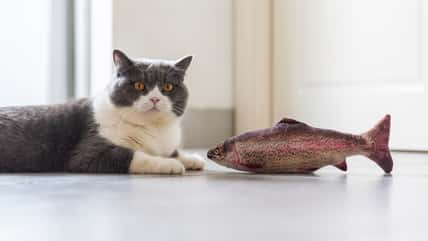In Maine, A One-Clawed Lobster Named Peaches Recently Welcomed 100 Rare And Colorful Lobster Babies Into The World

A group of tiny baby lobsters of a rare variety were hatched recently at the University of New England in Maine. The reason they’re so rare is because of their unique coloration. They were born to a bright orange, one-clawed lobster named Peaches.
Typically, lobsters are brown or mottled in appearance. But, in rare cases, they can be orange, blue, yellow, red, purple, and white.
Many of these exceptional individuals are housed at the university, so researchers can study the genes that lead to the varieties of color. Their rarity ranges from one in one million to one in 50 million.
The chances of a lobster being orange are one in 30 million. Peaches is the proud mother of 100 baby lobsters. They joined another pair of orange oceanic specimens. Norma, a second orange mother lobster, had 40 babies, and the third, Pineapple, is expecting to give birth soon.
Peaches’ babies are part of a research project to decode the genetic basis for these lobsters’ colorful shells.
Colorful lobsters are the result of a genetic mutation that affects the proteins that bond with shell pigments. The lack of one or more proteins can manifest as different hues.
Researchers are developing non-invasive methods to extract genetic samples from the animals. They will also monitor the growing lobsters to see how many of them will match their mothers’ orange hue. So far, some of the rare babies are even blue.
“At this point, no one really knows in detail why some lobsters develop these multicolor variations, though we do have some theories,” said Markus Frederich, a professor of marine sciences at the University of New England. “We hope to use this gene expression research to study the molecular biology of these creatures in a way that is not harmful to the lobsters.”
Another oddity at the university is a blue and brown lobster named Currant. The chances of finding a dual-colored lobster are one in 50 million.

NPD stock – stock.adobe.com – illustrative purposes only, not the actual lobster
There is also Fig, a one-in-a-million purple lobster. Peaches was welcomed to the institution in June 2023, where she happily feasts on fresh soft shell clams.
Peaches was discovered by a lobstering crew in Maine’s Casco Bay. Orange American lobsters can be found from southern New England to Nova Scotia in Canada.
At the time of her discovery, she was between five and seven years old, measured 10.8 inches in length, and was missing a claw.
It is unknown how she lost her claw, but it should eventually grow back. According to Frederich, lobsters often lose their claws during fights with other lobsters, attacks from predators, or when molting.
It isn’t the first time that the lobstering crew has encountered a special crustacean. Last time, they caught a calico lobster, another one in 30 million lobster, which they also gave to the university.
Sign up for Chip Chick’s newsletter and get stories like this delivered to your inbox.
More About:Animals





